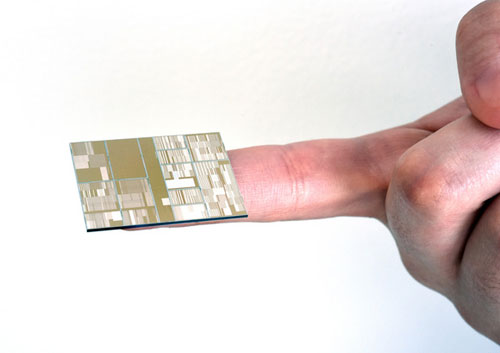Looks like Moore’s Law has some life in it yet, though creating a 7nm chip required exotic techniques and materials.
How far can we push Moore’s Law? It’s starting to become a concerning question as processors push into almost infinitesimally small process nodes.
Intel’s 14-nanometer Broadwell chips suffered from lengthy delays, stuttering Intel’s vaunted tick-tock manufacturing schedule. TSMC, the company that manufactures graphics processors for AMD and Nvidia, has been stuck at the 28nm node for yearsnow. Intel plans to push into 10nm in 2017, but IBM’s looking beyond that, and just revealed the world’s first working 7nm processor—but it took some pretty exotic manufacturing to get there.
Creating a working 7nm chip required moving past pure silicon, IBM revealed. IBM—working with GlobalFoundries, Samsung, SUNY Polytechnic Institute, and others—carved the transistor channels out of silicon-germanium (SiGe) alloy in order to improve electron mobility at such a small scale. Intel has also said 10nm will be the last gasp for pure silicon chips.
IBM and co. had to turn to cutting-edge lithography techniques to etch features onto the chip. The companies utilized extreme ultraviolet lithography, which Intel has also been investing heavily in for years now. The details behind EUV get complicated, but essentially, it’s a beam of light with a far narrower wavelength (read: width) than current lithography tools. The benefits of moving to a smaller feature-etching tool when working on a chip with 7nm components is obvious.
The consortium also managed to stack the chip incredibly tightly, with a 30nm transistor pitch, which helped it achieve a nearly 50-percent surface area reduction over today’s top-end chips.
The 7nm SiGe chips are nowhere near production-ready, but when they’re cleared for commercial use around 2017, IBM says they’ll result in “at least a 50 percent power/performance improvement for next generation… systems” on account of all those process improvements. Ars Technica has a wonderfully detailed write-up on the manufacturing process for IBM’s 7nm chips.
But that’s not even the most impressive number. IBM says that when the industry embraces 7nm manufacturing techniques, processors will be able to be stuffed with an incredible 20 billion transistors. By comparison, Intel’s new Broadwell-U processors pack “only” 1.9 billion transistors.
Source: www.pcworld.com
